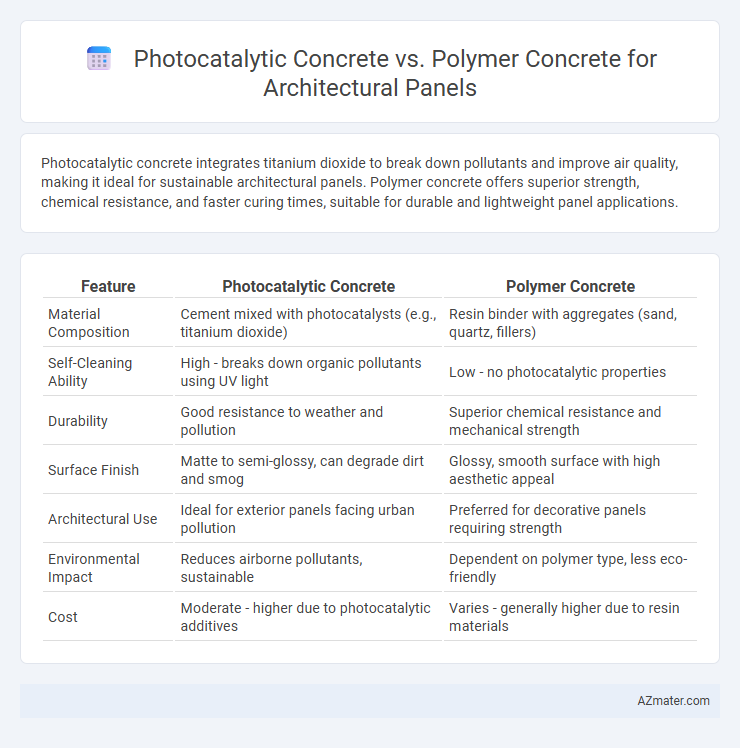Photocatalytic concrete integrates titanium dioxide to break down pollutants and improve air quality, making it ideal for sustainable architectural panels. Polymer concrete offers superior strength, chemical resistance, and faster curing times, suitable for durable and lightweight panel applications.
Table of Comparison
| Feature | Photocatalytic Concrete | Polymer Concrete |
|---|---|---|
| Material Composition | Cement mixed with photocatalysts (e.g., titanium dioxide) | Resin binder with aggregates (sand, quartz, fillers) |
| Self-Cleaning Ability | High - breaks down organic pollutants using UV light | Low - no photocatalytic properties |
| Durability | Good resistance to weather and pollution | Superior chemical resistance and mechanical strength |
| Surface Finish | Matte to semi-glossy, can degrade dirt and smog | Glossy, smooth surface with high aesthetic appeal |
| Architectural Use | Ideal for exterior panels facing urban pollution | Preferred for decorative panels requiring strength |
| Environmental Impact | Reduces airborne pollutants, sustainable | Dependent on polymer type, less eco-friendly |
| Cost | Moderate - higher due to photocatalytic additives | Varies - generally higher due to resin materials |
Introduction to Photocatalytic and Polymer Concrete
Photocatalytic concrete incorporates titanium dioxide (TiO2) nanoparticles, enabling it to break down pollutants and improve air quality through a self-cleaning effect, making it ideal for sustainable architectural panels. Polymer concrete utilizes polymer resins as a binder instead of traditional cement, offering enhanced durability, chemical resistance, and faster curing times suitable for decorative and structural panel applications. Both materials provide innovative solutions for architectural panels, with photocatalytic concrete focusing on environmental benefits and polymer concrete emphasizing mechanical performance and longevity.
Material Composition and Properties
Photocatalytic concrete incorporates titanium dioxide nanoparticles that enable it to break down pollutants and self-clean surfaces under UV light, enhancing durability and environmental benefits. Polymer concrete consists of a polymer binder, such as epoxy or polyester resin, combined with aggregate materials, offering superior chemical resistance, high tensile strength, and faster curing times compared to traditional cement-based concrete. The material composition of photocatalytic concrete provides active environmental functions, while polymer concrete focuses on enhanced mechanical performance and resistance to aggressive conditions in architectural panel applications.
Environmental Impact and Sustainability
Photocatalytic concrete incorporates titanium dioxide to reduce pollutants by breaking down organic compounds and nitrogen oxides, promoting cleaner air and lower environmental footprints in urban architecture. Polymer concrete uses synthetic resins as binders, which can introduce volatile organic compounds (VOCs) and pose recycling challenges, although it offers superior durability and chemical resistance, potentially extending the panel lifespan and reducing resource consumption. The sustainability of photocatalytic concrete is closely linked to its ability to actively mitigate pollution, while polymer concrete's environmental impact depends heavily on resin source and end-of-life management.
Self-Cleaning and Air-Purifying Capabilities
Photocatalytic concrete incorporates titanium dioxide, enabling it to break down pollutants and organic dirt when exposed to sunlight, granting superior self-cleaning and air-purifying properties ideal for architectural panels. Polymer concrete, while durable and resistant to chemicals, lacks inherent photocatalytic activity, making it less effective for environmental remediation. The integration of photocatalysts in concrete panels significantly improves urban air quality by reducing nitrogen oxides and organic contaminants on building surfaces.
Durability and Weather Resistance
Photocatalytic concrete features titanium dioxide additives that enhance self-cleaning properties and resist weathering by breaking down pollutants, making it highly durable in urban environments. Polymer concrete incorporates resin binders, providing superior resistance to chemical attack, freeze-thaw cycles, and abrasion, which ensures long-term structural integrity for architectural panels. While photocatalytic concrete excels in pollution mitigation and surface longevity, polymer concrete offers enhanced mechanical strength and moisture resistance, ideal for harsh climates.
Aesthetic Versatility and Design Options
Photocatalytic concrete offers superior aesthetic versatility with its self-cleaning properties and ability to maintain bright, clean surfaces over time, making it ideal for dynamic architectural panels exposed to pollution. Polymer concrete provides extensive design options due to its high moldability and wide range of color and texture possibilities, allowing for intricate shapes and customized finishes. Both materials enhance architectural design flexibility, but photocatalytic concrete excels in long-term visual maintenance while polymer concrete offers greater form and finish adaptability.
Installation and Maintenance Requirements
Photocatalytic concrete for architectural panels requires minimal maintenance due to its self-cleaning properties, which break down pollutants and reduce dirt accumulation over time. Installation demands careful handling to preserve the photocatalytic surface, often necessitating specialized techniques and protective measures during curing. Polymer concrete panels offer quick installation with lightweight properties and less curing time, but require regular inspections to prevent polymer degradation and maintain structural integrity.
Cost Analysis and Lifecycle Value
Photocatalytic concrete for architectural panels typically incurs higher initial costs due to advanced titanium dioxide additives, but offers long-term savings by reducing maintenance through self-cleaning and pollution-degrading properties. Polymer concrete panels, while having lower upfront costs and superior chemical resistance, may require more frequent replacement or repairs, impacting lifecycle value negatively. Evaluating total cost of ownership shows photocatalytic concrete can provide greater value over time by extending panel durability and reducing cleaning expenses in urban environments.
Performance in Urban Architectural Applications
Photocatalytic concrete enhances urban architectural panels by actively reducing air pollution through titanium dioxide's photocatalysis, leading to self-cleaning surfaces and improved environmental quality. Polymer concrete offers superior mechanical strength, chemical resistance, and durability, ensuring long-lasting performance under harsh urban conditions. Combining photocatalytic properties with polymer binder technology optimizes panels for sustainable city environments, balancing air purification with structural resilience.
Future Trends in Architectural Panel Materials
Photocatalytic concrete integrates titanium dioxide to enhance air purification and self-cleaning properties, making it a sustainable choice in urban architectural panels. Polymer concrete offers high durability, chemical resistance, and lightweight features, ideal for intricate designs and rapid installation. Future trends emphasize combining photocatalytic functions with polymer matrices to create hybrid panels that optimize environmental benefits and structural performance.

Infographic: Photocatalytic concrete vs Polymer concrete for Architectural panel
 azmater.com
azmater.com